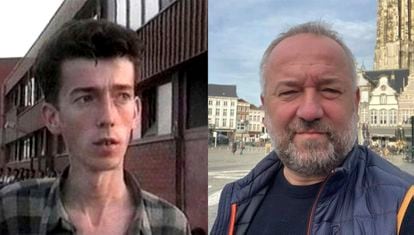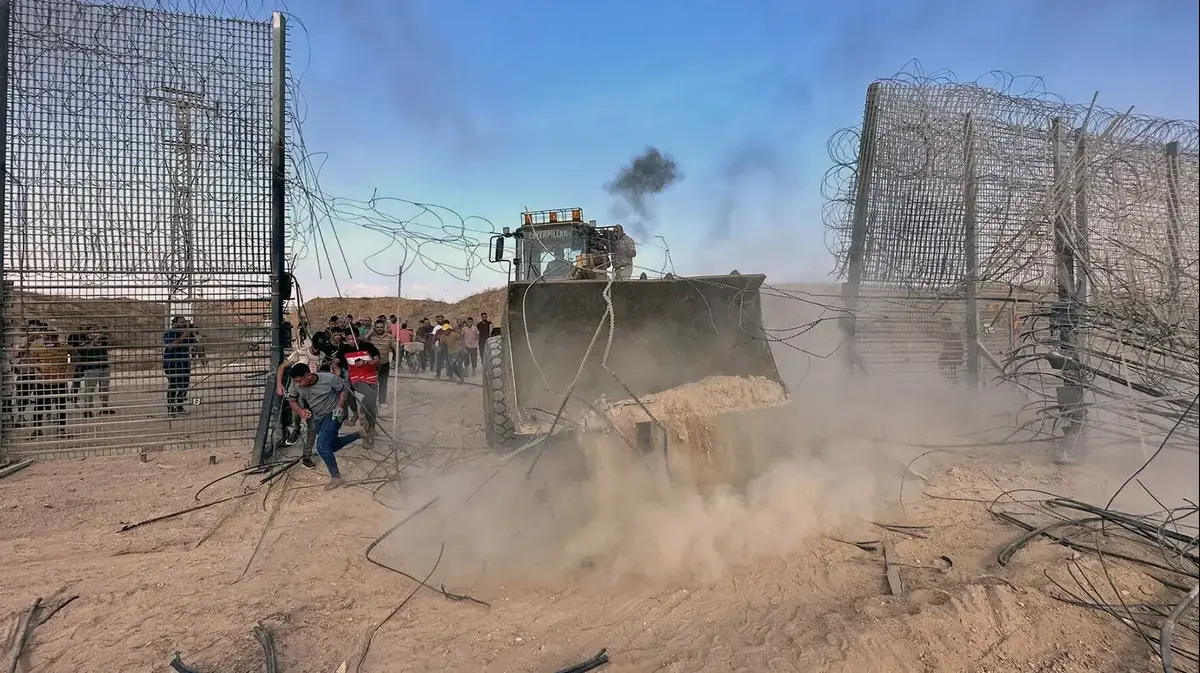On the left, Fikret Alic, in 2017 during the Ratko Mladic trial in The Hague;
on the right, the cover of the 1992 'Time' magazine in which it appears.
/ EFE
On August 17, 1992, the US magazine
TIME
published on the cover one of those photographs that soon became an icon of horror. The image of a cadaverous person surrounded by people behind a barbed wire during the Bosnian war symbolized the return to European soil from concentration camps half a century after the Holocaust. The photograph - in which everything except Fikret Alic's smile visually refers to the Nazi genocide - was taken by a group of British journalists in Trnopolje, one of the three camps set up by Bosnian Serb forces near the Bosnian city of Prijedor, considered today one of the main symbols of barbarism in that conflict.
Almost thirty years later, last February, the host of a Serbian television morning show Happy TV, Milomir Maric, and one of his guests, Predrag Antonijevic - director of the controversial film
Dara de Jasenovac
, the country's candidate in the last Oscars -, they had a conversation on the program in which Alic was described without naming him as "the skinny guy" who had "tuberculosis" and the camp, as a place where you could leave freely and that the Bosnian Serbs had installed "to prevent someone from kill ”the inmates. “Then they fed him [Alic], they took the skinny guy away and showed him in a circus around Europe. That's their propaganda, ”Maric said.
The dialogue is not an exceptional episode in a country that, like the Republika Srpska (the Bosnian Serb entity, created at the end of the war in 1995), has difficulties assuming its role in the wars in the former Yugoslavia, with the permanent feeling that the Serbs are demonized, that the massacres they committed in the wars of the 1990s are not contextualized, and that the atrocities of the enemy are ignored. The top Bosnian Serb leader, Milorad Dodik, one of Bosnia's three rotating presidents, actually considers the Srebrenica genocide to be "the greatest myth of the 20th century."
Despite not being an isolated episode, to Satko Mujagic, a survivor of the Omarska camp, the television dialogue seemed like a spit on his pain that, this time, he did not want to miss.
“I thought: 'what else is needed?'
First they did all that harm to us […].
And, 25 years later, I have to hear on public television that the place where I was detained was not a field.
It was not anonymous people denying what happened in comments on the Internet, it was state television, followed by hundreds of thousands of people.
I felt: 'Enough is enough,' says Mujagic from the Netherlands, where he rebuilt his life after landing as a refugee.
On the left, Satko Mujagic, in the Omarska camp in August 1992, in a screenshot of a video recorded by Serbian television.
On the right, last October in the Belgian city of Mechelen.
Mujagic, 49, with a law degree from the University of Amsterdam, then contacted a Belgrade lawyer known in the field of human rights and telephoned Fikret Alic. The two agreed to submit, together with the Association of Detainees of the Kozarac Camp (which has 3,200 members), a protest to the regulatory body for electronic media in Serbia, REM. In its response last May, REM acknowledged the personal offense to Alic, but dismissed the claim.
Faced with rejection, they decided to go one step further and go to court. Last July, they filed a lawsuit in the Belgrade administrative court against the regulatory body for it to be forced to reconsider. It has not yet been resolved, which is why REM refuses to rule on the matter, considering that "any comment" it made "could be interpreted as pressure on the court and other participants in the procedure," it says in a written response. to this newspaper.
Alic, who today lives in Bosnia after a long time in Copenhagen, is part of the lawsuit, but lives it with more emotional distance. “It is unfortunate to see that today some make fun of our suffering and deny it, although personally I do not pay much attention to it, because I know what we are experiencing. And it is not a matter of opinion, as confirmed by our testimonies and the trials in the courts of both Great Britain and Bosnia-Herzegovina. So I think it would be good to punish the deniers of genocide with a view to looking to the future. And for that you need to have a clear idea of what happened and face the truth, "he says in a series of messages in response to a questionnaire.
During the Bosnian war (1992-1995), Bosnian Serb forces established dozens of camps, transferring both civilians and Bosnian and Bosnian-Croat combatants and committing murder and rape, as well as beatings and under-feeding of soldiers. captives, as ruled by international justice.
From his months in Trnopolje, Alic remembers “the harsh conditions”, but also “the constant fear”.
“We feared what each new day might bring and we didn't know if we would survive.
Along with fear, hunger and various diseases reigned, and we lived in extremely inhuman conditions, "he says.
Die for the conditions
When Alic was in Trnopolje, Mujagic was in a nearby camp, Omarska, in which some 700 of the around 6,000 people it housed were killed. "Some, and I saw one with my own eyes, just exhausted," recalls Mujagic, then 20 years old. “We did not have enough food, we slept on the floor, many of us were beaten, there were no medications or showers. Even going to the bathroom was dangerous. Under these conditions, many people became ill, there was dysentery ... At one point, the conditions were already so unbearable that people began to die from them, instead of being murdered ”.
On August 5, 1992, considers Mujagic, he saved their lives. It was the day that a group of British journalists - including Ed Vulliamy, who years later would become the first since the Nuremberg trial to testify in a war crimes trial - visited the camps, surprisingly at the invitation of the leader. Bosnian Serb politician Radovan Karadzic. “In the days before, the killings became more systematic. More and more people were being called out and taken away. We later learned that they were all buried. I didn't know it at the time, but I was in the next group, ”he says. During the journalistic visit to Omarska, when asked about the conditions, one of the prisoners replied: "I do not want to tell lies, but I cannot tell the truth." Then a cameraman recorded Alic passing Trnopolje.Days after the publication of the image, Bosnian Serbs removed the barbed wire around the fields and improved conditions for the inmates.
Mujagic is 49 years old today and works for the European Commission in the evaluation of compliance with the rules of the Schengen zone. Despite this complaint and another that he has filed against President Dodik for discrimination and hate crime, he assures that he has taken his foot off the accelerator of activism, which he clung to to deal with the pain. “At Omarska we saw and experienced things that a human being is not supposed to see. Life as we knew it ended there. I don't remember ever having laughed once in four years. In 1993 I tried to commit suicide. I found work quickly, which helped me a lot to be busy; and I started a family… but Omarska was always there. I will never get over it. It is part of my life, but it no longer dominates it ”.
Follow all the international information on
and
, or in
our weekly newsletter
.








/cloudfront-eu-central-1.images.arcpublishing.com/prisa/2C5HI6YHNFHDLJSBNWHOIAS2AE.jpeg)




